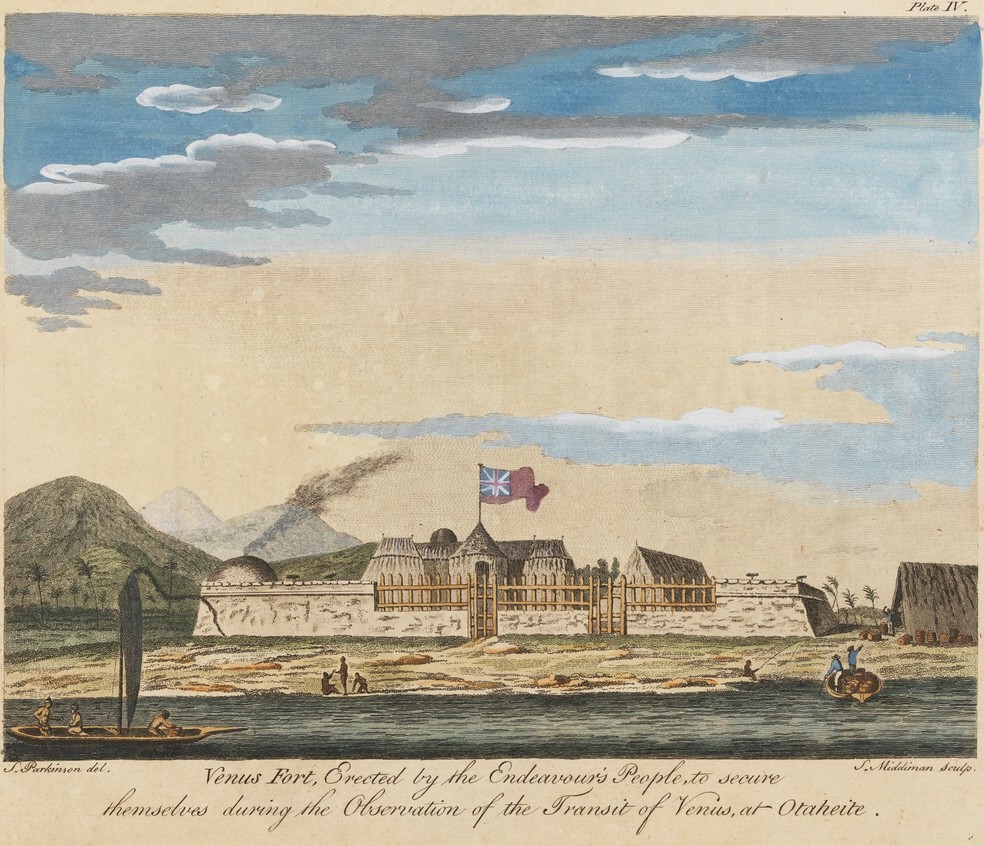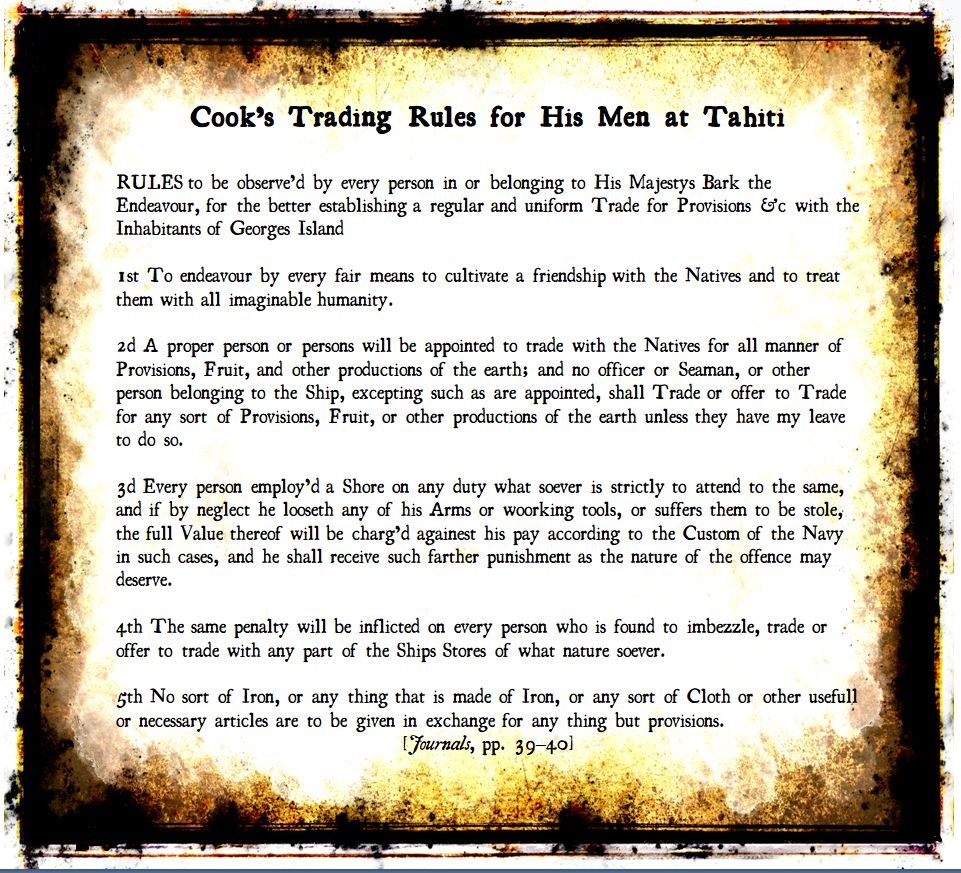This dance celebrates Captain Cook’s great scientific voyage of exploration aboard the Endeavour. In 1768, urged by the Royal Society, the British government decided to send an expedition to the newly discovered island of Tahiti to observe the transit of the planet Venus across the face of the Sun.
This was the most important scientific mission Britain had ever launched. With advances in mathematics, scientists believed by observing the Transit of Venus from different locations around the world, the distance between the Earth and the Sun could be calculated and thus, the size of our solar system could be defined.
After a voyage of eight months, Cook was proud to record that his crew had arrived in Otaheiti (as Tahiti was then known) as fit and healthy as when they left England, thanks to a regime which involved keeping the ship clean and well-ventilated, good personal hygiene, obtaining fresh provisions whenever possible, frequent issues of sauerkraut and other foods to combat scurvy, and regular dancing to fiddle, fife and drum.
At Tahiti they were welcomed by the friendly and happy people, and Cook tried to select a site for the fort in a location which he believed was “of no use” to the Tahitians due to of its apparent infertility, and it being distant from any of their habitations. He also attempted to communicate with the locals: – “we endeavour’d to explain as well as we could that we wanted that ground to sleep upon such a number of nights and then we should go away”.

Fort Venus. A journal of a voyage to the South Seas by Sydney Parkinson. London, 1784. Courtesy of State Library of New South Wales
In six weeks, a large fort was constructed including a forge, bakery, and space to house forty-five men in tents. Apart from its primary role as an observatory, the fort provided a site for cultural interaction and exchange, hospitality, punishment. Cook was keen to maintain good relations with the Tahitians, and issued a set of rules for his crew, including the stipulation that they “endeavour by every fair means to cultivate a friendship with the natives and to treat them with all imaginable humanity”.
On 3rd June, 1769, the transit, which would not occur again for more than a century, was observed from three different locations around the island. This imperative task completed, Cook opened the secret instructions from the Admiralty which directed him to discover and chart the mythical great southern land, Terra Australis Incognito.
The Endeavour’s return to England after three years of exploration was met by a flurry of press reports which highlighted the work of Joseph Banks, the wealthy and influential botanist who had accompanied Captain Cook to the south seas. Whilst Cook himself soon embarked on a second voyage and was not in England to receive the accolades he deserved, Banks, the handsome and articulate scientist, noted member of the London salon scene, was feted by royalty and high society and proclaimed a hero of the Enlightenment. His charming aristocratic manner was said to act as a magnet to the opposite sex.
It is quite possible the charming Joseph Banks inspired this dance.

Bride’s Favourite Collection Of Two Hundred Country Dances. 1775. Courtesy of Kate Van Winkle Keller.
Listen to Transit of Venus Arr. by Roland Clarke. Available on our new CD
Country dance: longways duple minor
| A1 | 1 – 8 | 1st couple turn by the right hand, face up and cast down one place. 2nd couple meet and lead up. |
| A2 | 1 – 8 | 1st couple turn by the left hand, face down and cast up one place. 2nd couple meet and lead down. |
| B1 | 1 – 4 | 1st couple lead down through their own 2nd couple and the next second couple [2nd couples move up]. Remain in the middle of the set. |
| 5 – 8 | Set or rigadoon, and cast up behind one couple into original second place. | |
| B2 | 1 – 4 | In original minor sets: 1st corner positions change places passing right shoulder [2nd man & 1st lady]. 2nd corner positions change places passing left shoulder [2nd lady & 1st man]. |
| 5 – 8 | Repeat: 1st corner positions change places passing right shoulder [2nd man & 1st lady]. 2nd corner positions change places passing left shoulder [2nd lady & 1st man]. |
Bride’s Favourite Collection of Two Hundred Country Dances. 1775.
____________________________________________________________________________________________________________________________
Agnew, V. (2001). A Scots Orpheus in the South Seas: Encounter music on Cook’s second voyage. Journal for Maritime Research, 3(1), 1-27.
Collingridge, V. (2003). Captain Cook Obsession and Betrayal in the New World. Great Britain: Ebury Press.
Cook, James, 1728-1779. The Journals of Captain James Cook on His Voyages of Discovery. Vol. I. The Voyage of the Endeavour, 1768-1771.
Cook, James, 1728-1779. Journal of the H.M.S. Endeavour & National Library of Australia (2008). Cook’s Endeavour journal : the inside story. National Library of Australia, Canberra
Keller, Kate Van Winkle. Copy of original from Bride’s Favourite Collection Of Two Hundred Country Dances. 1775.
Mundle, R., & Australian Broadcasting Corporation. (2013). Cook: From sailor to legend. Sydney, NSW: ABC Books.
National Library of Australia. Venus Fort, Erected by the Endeavour’s People to secure themselves during the Observation of the Transit of Venus, at Otaheite. By Samuel Middiman (1750-1831), after drawings by Sydney Parkinson and possibly Herman Diedrich Sporing. Engraved for inclusion as plate iv within Sydney Parkinson’s Journal of a Voyage to the South Seas…, London, 1773. Location: South Seas Digital Version
Ross, Emma Lewis. (2012) Visualizing Tahiti: Enlightenment Exploration
https://visualizingtahiti.wordpress.com/visualizing-three-dimensionally/fort-venus/
_______________________________
The Brisbane-based dance group Kaleidoscope has an animation of the Transit of Venus which shows the basic pattern of the dance.
Visit them at http://www.dancekaleidoscope.org.au/dance.html#TransitOfVenus
______________________________________________________________
Header credits:
1. Portrait of Captain Cook by Nathaniel Dance-Holland [Public domain]2. A jig on board by Cruikshank. Courtesy of The Lewis Walpole Library, Yale University
3. View of the South Seas by John Cleveley the Younger [Public domain]
______________________________________________________________
The information on this website www.historicaldance.au may be copied for personal use only, and must be acknowledged as from this website. It may not be reproduced for publication without prior permission from Dr Heather Blasdale Clarke.






One Response to Transit of Venus